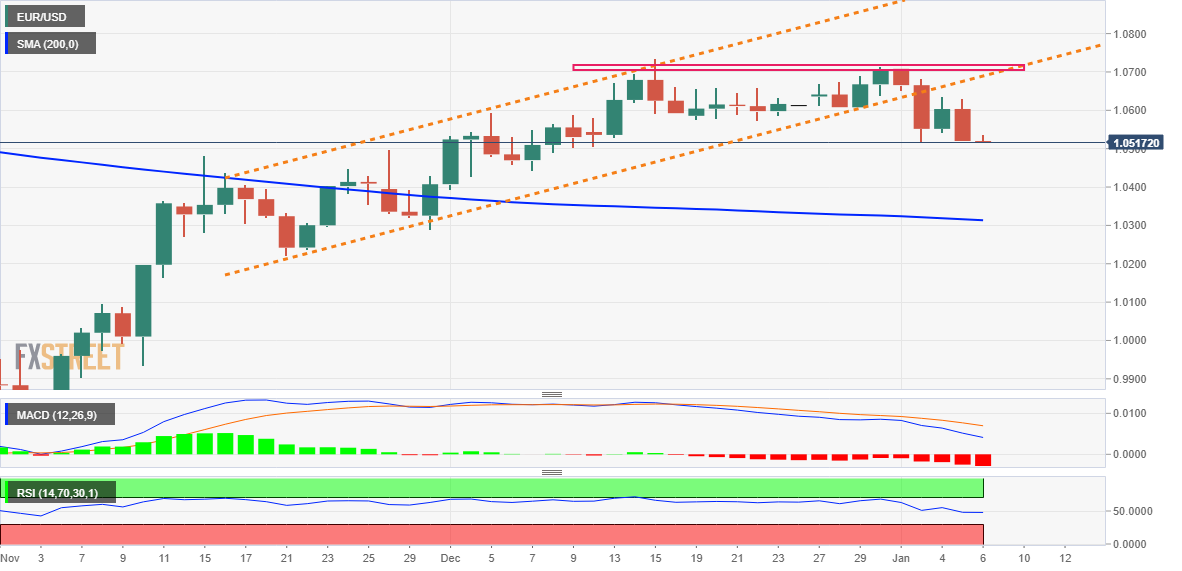- EUR/USD dropped to over a three-week low on Thursday amid resurgent USD demand.
- The downside remains limited as traders await the Eurozone CPI and the US NFP report.
- The fundamental backdrop and technical setup supports prospects for a further downside.
The EUR/USD pair came under heavy selling pressure on Thursday and dived to over a three-week low amid resurgent US Dollar demand, bolstered by upbeat US macro data. According to the report published by Automatic Data Processing (ADP), the US private sector employers added 235K jobs in December against consensus estimates for a reading of 150K. Moreover, Initial Jobless Claims unexpectedly declined to 204K in the last week of December from the previous week's downwardly revised print of 223 K. This pointed to a resilient US labour market and indicated that the economy ended 2022 on solid footing, which could allow the Federal Reserve to stick to its aggressive rate hike path.
This, along with hawkish comments by Kansas City Fed President Esther George, forecasting rates above 5% for some time, triggered a sharp spike in the US Treasury bond yields. Apart from this, a fresh leg down in the US equity markets provided a strong boost to the safe-haven greenback. The shared currency, on the other hand, was undermined by speculations that the European Central Bank could opt for a gradual approach towards tightening its policy amid signs of easing inflationary pressures. It is worth recalling that the recent data released from Germany, France and Spain showed a surprise decline in consumer inflation during December, suggesting that the peak is already behind.
Despite the aforementioned negative factors, the EUR/USD pair manages to find some support ahead of the 1.0500 psychological mark and edges higher during the Asian session on Friday. Traders seem reluctant to place aggressive bets and prefer to move on the sidelines ahead of the key macro releases. The next test for the Euro comes in the form of the flash Eurozone CPI print, though the focus remains glued to the closely-watched US monthly jobs data. The popularly known NFP report could influence the Fed's near-term policy outlook. This, in turn, will play a key role in driving the USD demand and help investors to determine the next leg of a directional move for the major.
Technical Outlook
From a technical perspective, the recent repeated failures to capitalize on moves beyond the 1.0700 mark and a subsequent breakdown below ascending channel support favour bearish traders. The outlook is reinforced by the fact that oscillators on the daily chart have just started drifting into negative territory. Some follow-through selling below the 1.0500 round figure will reaffirm the bias and make the EUR/USD pair vulnerable to testing the next relevant support near the 1.0410-1.0400 area. The downward trajectory could get extended further towards the very important 200-day SMA, currently around the 1.0315-1.0310 region.
On the flip side, any meaningful recovery attempt might now confront a stiff barrier and meet with a fresh supply near the 1.0600 mark. This is followed by the aforementioned ascending channel support breakpoint, now turned resistance near the 1.0625-1.0635 region. A sustained strength beyond could trigger a short-covering move and allow the EUR/USD pair to aim back to conquer the 1.0700 round figure. Bulls, however, are likely to wait for some follow-through buying beyond the December monthly swing high, around the 1.0735 zone, before positioning for any further appreciating move.






